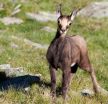(Press-News.org) LAWRENCE — Whiplash the Cowboy Monkey. Grumpy Cat. "Peanut," the Ugliest Dog in the World. These might be a sampling of the most familiar animals to millions of users of social networking sites like Facebook.
But one doctoral student in geography at the University of Kansas recognizes social networking sites as a potential boon for scientifically documenting Earth's biodiversity, particularly in developing nations. In fact, for this idea, Vijay Barve was just honored with a Young Researchers Award from the Global Biodiversity Information Facility, an international organization focused on making scientific data on biodiversity available via the Internet.
Barve said that social networks could supplement data available via established biodiversity web sites.
"Though data about birds is available on sites like GBIF, social networking would add a lot of data on groups like butterflies, moths and other insects," he said. "Basically any organism which can be identified using photographs to certain confidence would be available on social networking sites."
In a paper recently published in the peer-reviewed journal Ecological Informatics, Barve demonstrated social networks to be a viable source for photo-vouchered biodiversity records, especially those that clarify which species exist in what places within developing nations.
"There are two main reasons why geographic and taxonomic gaps exist in developing nations," he said. "First, because of colonial history, most of the historical collections are deposited with European museums and are not largely digitized yet due to lack of priority. Second, most developing countries have not invested in curating and digitizing biodiversity in their collections yet."
Barve has pored over photos of monarch butterflies and snowy owls on the photo-sharing social network Flickr, finding them to be a rich source of biodiversity data. Not just photos, but also their associated metadata, make this possible, he said.
"We need a date, place — meaning coordinates not just the name of the place and who has seen it," he said. "Identifications could be done by naturalists and experts."
But Barve stressed that photos from non-experts would be valuable to two of the three broad classes of occurrence records used by scientists: directed surveys and broad-scale surveys.
"Anybody with camera who takes pictures of curious creatures would contribute to what I am harvesting," he said. "The person posting needs to tag the photo with any term indicating a biodiversity element. That's the requirement to show that item in my searches."
Barve said the inspiration for scouring social media networks came from a class he took at KU.
"I've been interested in biodiversity since my childhood and have been watching birds and butterflies with interest," he said. "While taking a neogeography class at KU, we were studying citizens as sensors and how they contribute a lot of geographic information. That research set me thinking about how I could apply that to my own research in biodiversity, and I started exploring this field."
While Barve selected Flickr to prove the usefulness of social media to biodiversity research, he said that any social network could be mined for worthwhile data, given a few requirements.
"The ability of social network sites to record the date photo was taken, rather than just posted, and geo-tagging the photo are most important," Barve said. "To automate the searches the social network sites should also provide extensive search and ability to access the site programmatically."
Barve, who coordinates DiversityIndia, a group interested in learning about biodiversity through social networks, also practices what he preaches as a regular user of social networks.
"I have been an active user of Yahoo groups, Flickr, Picasa and Facebook," he said. "I post lot of small insects and butterflies that I photograph all the time."
INFORMATION:
CAMBRIDGE, Mass--The boom in oil and gas produced through hydraulic fracturing, or fracking, is seen as a boon for meeting U.S. energy needs. But one byproduct of the process is millions of gallons of water that's much saltier than seawater, after leaching salts from rocks deep below the surface.
Now researchers at MIT and in Saudi Arabia say they have found an economical solution for removing the salt from this water. The new analysis appears this week in the journal Applied Energy, in a paper co-authored by MIT professor John Lienhard, postdoc Ronan McGovern, and four ...
This news release is available in German. Conventional magnetic resonance imaging (MRI), well-known from its use in hospitals, can typically resolve details of up to one tenth of a millimetre, for example in cross-sectional images of the human body. Together with colleagues at the University of Leipzig, researchers of ETH Zurich are working on massively increasing the resolution of the technique, with the goal of eventually imaging at the level of single molecules – demanding an over one million times finer resolution. By detecting the signal from a single hydrogen ...
(Austin, Texas) October 21, 2014 – The largest study to date of mortality trends in patients with acute respiratory distress syndrome (ARDS) shows that the rate of mortality dropped significantly over a 16-year period. Advances in critical care medicine are seen as a direct cause of the decline. The study abstract was released today in an online supplement of the of the journal CHEST and will be presented at CHEST 2014, the annual meeting of the American College of Chest Physicians in Austin, Texas held October 25-30.
Researchers at Rutgers Robert Wood Johnson Medical ...
(Austin, Texas) October 21, 2014 – Patients who use a continuous positive airway pressure (CPAP) device to treat obstructive sleep apnea (OSA) often believe that it makes them less sexually attractive, according to researchers at Rosalind Franklin University. A new study abstract released today in an online supplement of the journal CHEST, to be presented at CHEST 2014, the annual meeting of the American College of Chest Physicians in Austin, Texas, shows that they do not need to worry.
Erectile dysfunction (ED) is common in sleep apnea patients, but studies have ...
Alpine goats appear to be shrinking in size as they react to changes in climate, according to new research from Durham University.
The researchers studied the impacts of changes in temperature on the body size of Alpine Chamois, a species of mountain goat, over the past 30 years.
To their surprise, they discovered that young Chamois now weigh about 25 per cent less than animals of the same age in the 1980s.
In recent years, decreases in body size have been identified in a variety of animal species, and have frequently been linked to the changing climate.
However, ...
(Austin, Texas) October 21, 2014 – A new study shows that patients with stage I to stage III non-small cell lung cancer have different metabolite profiles in their blood than those of patients who are at risk but do not have lung cancer. The study abstract was released today in an online supplement of the journal CHEST and will be presented at CHEST 2014, the annual meeting of the American College of Chest Physicians in Austin, Texas, on October 29.
Researchers at Cleveland Clinic studied the blood serum of 284 subjects, 48% of whom were female with a mean age of ...
WASHINGTON, Oct. 21, 2014 — It's National Chemistry Week, and this year's theme is the sweetest of all: candy. Whether it's ice cream, candy bars, pudding or cake, we love our sweets. But why do those treats actually taste sweet? Whether they're made with sugar or artificial sweeteners, it all comes down to chemistry. Find out more here: http://youtu.be/FaBFyEa8-eI.
Subscribe to the series at Reactions YouTube, and follow us on Twitter @ACSreactions to be the first to see our latest videos.
INFORMATION:The American Chemical Society is a nonprofit organization ...
The way in which male moths locate females flying hundreds of meters away has long been a mystery to scientists.
Researchers know the moths use pheromones to locate their mates. Yet when these chemical odors are widely dispersed in a windy, turbulent atmosphere, the insects still manage to fly in the right direction over hundreds of meters with only random puffs of their mates' pheromones spaced tens of seconds apart to guide them.
"The male moths are flying toward females integrating all of this information along the way and somehow getting to them," said Massimo Vergassola, ...
An international team of physicists has measured a subtle characteristic in the polarization of the cosmic microwave background radiation that will allow them to map the large-scale structure of the universe, determine the masses of neutrinos and perhaps uncover some of the mysteries of dark matter and dark energy.
In a paper published this week in the Astrophysical Journal, the POLARBEAR consortium, led by University of California, Berkeley, physicist Adrian Lee, describes the first successful isolation of a "B-mode" produced by gravitational lensing in the polarization ...
CORVALLIS, Ore. – Children who show poor decision-making skills at age 10 or 11 may be more likely to experience interpersonal and behavioral difficulties that have the potential to lead to high-risk health behavior in their teen years, according to a new study from Oregon State University psychology professor.
"These findings suggest that less-refined decision skills early in life could potentially be a harbinger for problem behavior in the future," said Joshua Weller, an assistant professor in the School of Psychological Science in OSU's College of Liberal Arts.
However, ...


